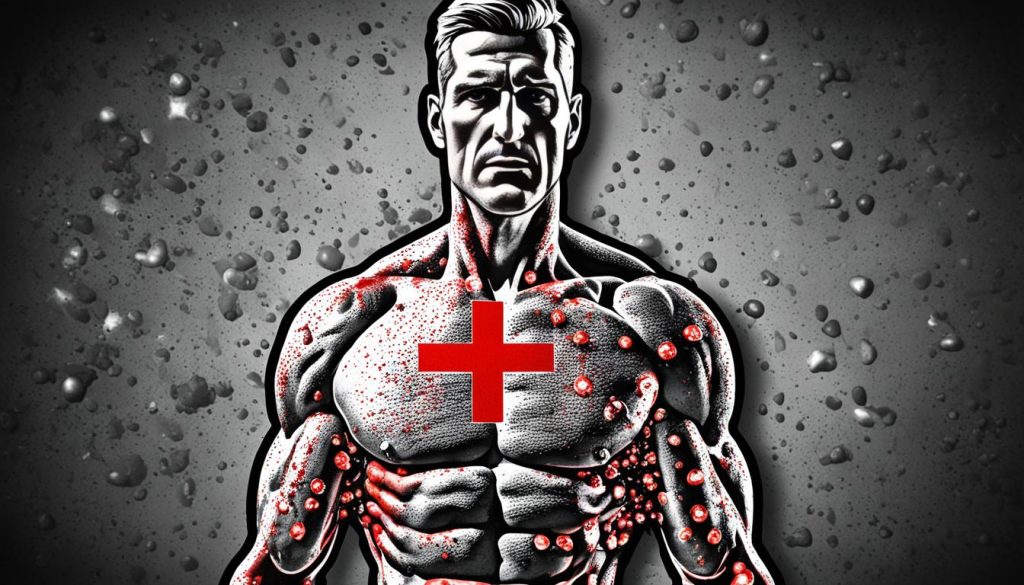Ad Blocker Detected
Our website is made possible by displaying online advertisements to our visitors. Please consider supporting us by disabling your ad blocker.
Testosterone therapy is often considered as a way to combat the effects of aging, but it’s important to understand the potential risks involved. Testosterone is a hormone that plays a crucial role in various bodily functions such as bone density, muscle strength, and sex drive. However, as you age, your testosterone levels naturally decline. Testosterone replacement therapy can help improve the signs and symptoms of low testosterone, but it’s essential to be aware of the potential side effects.
Some of the risks associated with testosterone therapy include worsening sleep apnea, acne or skin reactions, noncancerous growth of the prostate, breast enlargement, decreased sperm production, increased red blood cell production, and an increased risk of heart disease. It’s crucial to have a thorough discussion with your doctor about the risks and benefits of testosterone therapy before considering it.
Key Takeaways:
- Testosterone therapy can improve the signs and symptoms of low testosterone, but it comes with potential risks and side effects.
- Some of the risks of testosterone therapy include worsening sleep apnea, acne or skin reactions, noncancerous growth of the prostate, breast enlargement, and an increased risk of heart disease.
- It’s essential to have a thorough discussion with your doctor to weigh the potential risks and benefits of testosterone therapy before starting treatment.
- Regular monitoring and follow-up appointments are necessary to ensure the effectiveness of the treatment and manage any potential side effects.
- Testosterone therapy should be considered only for men with clinically low testosterone levels, under the guidance of a healthcare professional.
Understanding Testosterone and Aging
As men age, their testosterone levels gradually decrease. This decline typically starts around the age of 30 or 40 and continues at a rate of about 1% per year. Low testosterone levels can lead to various signs and symptoms, including changes in sexual function, physical changes such as increased body fat and decreased muscle mass, emotional changes like decreased motivation or confidence, and decreased energy levels. However, it’s important to note that these symptoms can also be caused by other factors such as medication side effects, sleep apnea, thyroid problems, and depression.
A blood test is used to diagnose low testosterone levels, and it’s important to determine if the low levels are due to normal aging or an underlying disease. Testosterone replacement therapy can help improve these symptoms in men with low testosterone levels.
Testosterone levels naturally decline as men age. This gradual decrease can lead to various signs and symptoms, including changes in sexual function, physical changes such as increased body fat and decreased muscle mass, emotional changes like decreased motivation or confidence, and decreased energy levels. However, it’s essential to consider other possible causes of these symptoms, such as medication side effects, sleep apnea, thyroid problems, and depression. A blood test is used to diagnose low testosterone levels and determine if they are due to normal aging or an underlying disease. Men with low testosterone levels may benefit from testosterone replacement therapy, which can help improve these symptoms.
Evaluating Testosterone Levels
When considering the signs and symptoms of low testosterone, it’s important to understand that they can vary and may be caused by factors other than aging. To accurately diagnose low testosterone levels, a blood test is necessary. This test measures the amount of testosterone in your body and helps determine if your levels are within the normal range for your age group. Your healthcare provider will evaluate the results of this test and consider additional factors, such as your medical history and physical examination findings, to determine if testosterone replacement therapy is appropriate for you.
Effects of Low Testosterone
Low testosterone levels can have various effects on the body. These effects can impact sexual function, physical appearance, emotional well-being, and overall quality of life. Understanding these effects can help you recognize the potential signs of low testosterone and seek appropriate treatment. Possible effects of low testosterone include:
- Changes in sexual function: Reduced libido, erectile dysfunction, and decreased quality of erections
- Physical changes: Increased body fat, decreased muscle mass and strength, decreased bone density
- Emotional changes: Decreased motivation, decreased confidence, increased irritability or mood swings
- Decreased energy levels and fatigue

Potential Benefits of Testosterone Therapy
Testosterone replacement therapy offers numerous benefits for men with clinically low testosterone levels. The effects of testosterone therapy extend beyond improving sexual function. Let’s explore some of the potential benefits:
1. Enhanced Sexual Function
One of the significant advantages of testosterone therapy is its impact on sexual function. It can help improve libido, erectile function, and overall sexual performance. Men with low testosterone levels often experience decreased sexual desire, difficulty achieving and maintaining erections, and reduced sexual satisfaction. Testosterone therapy can potentially alleviate these symptoms and enhance sexual function.
2. Increased Muscle Strength and Mass
Testosterone plays a vital role in influencing muscle strength and mass. It promotes protein synthesis, which is crucial for muscle development. Low testosterone levels can lead to muscle weakness, fatigue, and decreased muscle mass. Testosterone replacement therapy can help reverse these effects, leading to increased muscle strength and mass.
3. Reduced Body Fat
Testosterone therapy can aid in reducing body fat. Low testosterone levels are associated with increased body fat and decreased lean muscle mass. By increasing testosterone levels, the therapy can help enhance metabolism and facilitate fat loss, leading to a more desirable body composition.
4. Improved Bone Density
Testosterone plays a critical role in maintaining bone health and density. Low testosterone levels can contribute to bone loss and increase the risk of osteoporosis in men. Testosterone replacement therapy can help improve bone density and reduce the risk of fractures, promoting overall bone health.
5. Positive Effects on Mood, Motivation, and Cognitive Function
Testosterone therapy may have positive effects on mood, motivation, and cognitive function in some individuals. Low testosterone levels have been associated with symptoms such as fatigue, irritability, decreased motivation, and cognitive decline. By restoring testosterone levels, therapy can potentially alleviate these symptoms, leading to improved mood, motivation, and cognitive functioning.
It’s important to note that the effects of testosterone therapy may vary from person to person and depend on individual factors such as age, overall health, and adherence to treatment. It’s crucial to consult with a healthcare provider to determine if testosterone therapy is suitable and can offer potential benefits based on your specific situation.

| Potential Benefits of Testosterone Therapy | Description |
|---|---|
| Enhanced Sexual Function | Improved libido, erectile function, and sexual performance |
| Increased Muscle Strength and Mass | Promotes muscle development, increases strength and mass |
| Reduced Body Fat | Enhances metabolism, aids in fat loss and body composition |
| Improved Bone Density | Enhances bone health, reduces the risk of osteoporosis |
| Positive Effects on Mood, Motivation, and Cognitive Function | Improves mood, motivation, and cognitive performance |
Risks of Testosterone Therapy
Testosterone therapy can provide benefits for men with low testosterone levels, but it’s important to understand the potential risks and side effects before starting treatment. It’s crucial to discuss these risks with your doctor and weigh them against the potential benefits to make an informed decision.
Potential Side Effects
- Worsening sleep apnea
- Acne or skin reactions
- Noncancerous growth of the prostate
- Breast enlargement
- Decreased sperm production
- Increased red blood cell production
- Increased risk of heart disease
These side effects can vary in severity and frequency among individuals. It’s important to discuss your medical history and any pre-existing conditions with your doctor to determine your specific risk profile.

Additionally, it’s worth noting that more research is needed to fully understand the long-term risks and benefits of testosterone therapy, especially in older men who are otherwise healthy. Ongoing monitoring and regular follow-up appointments with your healthcare provider are essential to closely monitor your progress and manage any potential side effects.
“It’s important to discuss the potential risks and side effects of testosterone therapy with your doctor before starting treatment. By having an open and honest conversation, you can make an informed decision that aligns with your individual health goals.”
Who Should Consider Testosterone Therapy?
Testosterone therapy may be appropriate for men who have clinically low levels of testosterone due to a condition known as hypogonadism. Hypogonadism occurs when the testicles or the pituitary gland, which controls the testicles, are unable to produce adequate amounts of testosterone.
If you are experiencing signs and symptoms of low testosterone, such as decreased energy levels, changes in sexual function, decreased muscle mass, or emotional changes, it is vital to undergo a comprehensive evaluation by a healthcare professional. This evaluation will help determine whether your low testosterone levels are a result of normal aging or an underlying medical condition.
Your doctor may measure your testosterone levels at least twice to ensure an accurate diagnosis. If it is determined that your testosterone levels are significantly low, testosterone replacement therapy may be recommended to alleviate the signs and symptoms of low testosterone.
It is crucial to remember that testosterone therapy should only be considered under the guidance of a healthcare professional and for individuals with clinically low testosterone levels. Evaluating your testosterone levels thoroughly and accurately is essential to make an informed decision about testosterone therapy.
Understanding Hypogonadism
Hypogonadism is a medical condition characterized by reduced or absent function of the testicles in men. It can manifest at birth (congenital) or develop later in life (acquired). There are two types of hypogonadism:
- Primary hypogonadism: This occurs when the testicles are unable to produce sufficient testosterone due to a problem within the testicles. Causes include genetic disorders, testicular injury, chemotherapy, radiation therapy, or mumps orchitis.
- Secondary hypogonadism: This occurs when the testicles are unable to produce adequate testosterone despite normal functioning testicles. It is usually caused by problems in the hypothalamus or pituitary gland, which regulate testosterone production. Causes include pituitary tumor, medications, obesity, or chronic illness.
A thorough evaluation by a healthcare professional can help determine the underlying cause of hypogonadism and guide the appropriate course of treatment, which may include testosterone therapy.
Forms of Testosterone Therapy
Testosterone therapy offers several options for the administration of testosterone to address low hormone levels. These options include injections, patches, gels, buccal patches, and subcutaneous pellets. Each form of therapy comes with its own set of benefits and considerations, ensuring that there is a suitable method for every individual’s needs.
Injections: Testosterone injections are given at intervals ranging from 2 to 10 weeks. This form of therapy is cost-effective compared to other options and allows for convenient administration.
Patches: Testosterone patches are easy to use and provide a steady release of the hormone. However, they can cause skin reactions or irritation at the application site.
Gels: Testosterone gels are a popular choice due to their convenience. They are applied topically and provide consistent hormone levels throughout the day. However, caution must be exercised to avoid accidental exposure of others to the testosterone gel.
Buccal patches: These small patches are placed on the upper gum and deliver testosterone through the oral mucosa. While easy to use, they may cause irritation or sensitivity in the mouth.
Subcutaneous pellets: Subcutaneous pellets are inserted under the skin and provide a sustained release of testosterone. They eliminate the need for frequent administration, as they only require re-implantation every 3 to 6 months. Once inserted, they offer a convenient and hassle-free option for testosterone therapy.
When choosing the most suitable form of testosterone therapy, it’s important to consider individual preferences, lifestyle, and medical considerations. Consulting with a healthcare provider will help determine the best option for optimizing hormone levels and achieving desired outcomes.
Pros and Cons of Testosterone Therapy:
Each method of testosterone administration has its own advantages and disadvantages. Here’s a closer look at the pros and cons:
| Method | Pros | Cons |
|---|---|---|
| Injections | Cost-effective | Requires regular administration |
| Patches | Easy to use | May cause skin reactions |
| Gels | Convenient application | Risk of accidental exposure to others |
| Buccal patches | Simple placement | Possible oral irritation |
| Subcutaneous pellets | Long-lasting effects | Requires minor surgical procedure for insertion |
Considering the pros and cons of each method will help you make an informed decision about the most suitable approach for your testosterone therapy.
Monitoring and Follow-Up
Once you start testosterone therapy, regular monitoring and follow-up appointments are necessary to assess the effectiveness of the treatment and manage any potential side effects. Your doctor will measure your testosterone levels at specific intervals, typically at 3- and 6-month marks after treatment initiation, and then annually thereafter. Red blood cell levels and bone density may also be evaluated during the course of therapy. Adjustments to the dosage may be made based on the testosterone levels and overall health status.
It’s important to communicate any concerns or changes in symptoms to your healthcare provider during follow-up visits to ensure the best possible outcomes.
| Frequency | Testosterone Levels | Red Blood Cell Levels | Bone Density |
|---|---|---|---|
| 3 months | ✓ | ✓ | |
| 6 months | ✓ | ✓ | |
| Annually | ✓ | ✓ |
Conclusion
When considering testosterone therapy, it is important to weigh the potential risks and benefits involved. While testosterone therapy can provide benefits for men with clinically low testosterone levels, it is crucial to have a thorough discussion with your healthcare provider before starting treatment. This discussion should include a clear understanding of the potential risks and side effects, as well as the expected outcomes.
Testosterone therapy should only be considered under the guidance of a healthcare professional and for men with clinically low testosterone levels. Regular monitoring and follow-up appointments are necessary to ensure the effectiveness of the treatment and manage any potential side effects. Your healthcare provider will monitor your testosterone levels and may make adjustments to the dosage based on your individual needs and health status.
Informed decision-making is key when it comes to testosterone therapy. By discussing the risks, potential side effects, and expected outcomes with your healthcare provider, you can make a decision that aligns with your individual needs and health goals. Remember, testosterone therapy should not be pursued for performance enhancement or anti-aging purposes. Make an informed decision and prioritize your health and well-being.
FAQ
What are the risks of taking testosterone?
Some potential risks of testosterone therapy include worsening sleep apnea, acne or skin reactions, noncancerous growth of the prostate, breast enlargement, decreased sperm production, increased red blood cell production, and an increased risk of heart disease.
What are the potential side effects of testosterone use?
Possible side effects of testosterone therapy may include sleep apnea, skin reactions, prostate growth, breast enlargement, decreased sperm production, increased red blood cell production, and an increased risk of heart disease.
What are the health risks of testosterone therapy?
Testosterone therapy carries risks such as worsening sleep apnea, skin reactions, prostate growth, breast enlargement, decreased sperm production, increased red blood cell production, and an increased risk of heart disease.
What are the dangers of testosterone supplementation?
The dangers of testosterone supplementation include potential side effects such as worsening sleep apnea, acne or skin reactions, noncancerous growth of the prostate, breast enlargement, decreased sperm production, increased red blood cell production, and an increased risk of heart disease.
What are the risks and benefits of testosterone replacement therapy?
Testosterone replacement therapy may offer benefits such as improved sexual function, increased muscle strength and mass, reduced body fat, and improved bone density. However, there are risks involved, including worsening sleep apnea, acne or skin reactions, noncancerous growth of the prostate, breast enlargement, decreased sperm production, increased red blood cell production, and an increased risk of heart disease.
What are the safety concerns of testosterone use?
Some safety concerns associated with testosterone therapy include worsening sleep apnea, acne or skin reactions, noncancerous growth of the prostate, breast enlargement, decreased sperm production, increased red blood cell production, and an increased risk of heart disease.
What are the complications of testosterone therapy?
Complications of testosterone therapy may include worsening sleep apnea, acne or skin reactions, noncancerous growth of the prostate, breast enlargement, decreased sperm production, increased red blood cell production, and an increased risk of heart disease.
Are There Risks Associated with Testosterone Therapy and its Effects on Sexual Function?
Testosterone therapy can potentially have risks associated with its effects on sexual function, including changes in libido and erectile function. Some men may experience difficulty achieving or maintaining erections, known as “testosterone effects on hardness“, as a result of hormone therapy. It’s important to discuss potential side effects with a healthcare provider.


